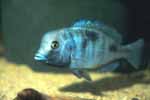May 23, 2003
http://www.ajc.com/news/...
 One newly bioengineered salmon, endowed with a gene from an eel-like fish,
grows five times faster than its natural cousins. Another genetically
modified salmon produces antifreeze in its blood so it can survive icy
waters that swirl through oceanic fish farms.
One newly bioengineered salmon, endowed with a gene from an eel-like fish,
grows five times faster than its natural cousins. Another genetically
modified salmon produces antifreeze in its blood so it can survive icy
waters that swirl through oceanic fish farms.
A tropical zebra fish, infused with the green fluorescent gene of a
jellyfish, glows in the dark -- a living novelty that promoters hope will be
a must-have for the home aquarium.
These experimental superfish are more than laboratory curiosities. They are
the progeny of genetic engineers whose skill at mixing and matching genes is
outpacing laws and regulations meant to protect the food supply and the
environment.
None of these designer fish, being pushed by biotech entrepreneurs as
potential lucrative ventures, has yet to reach the market. But the U.S. Food
and Drug Administration has initiated a review of the souped-up salmon, a
process that could lead to the first approval of a "transgenic" animal --
one that has genetic material transplanted from another.
Although the human health implications of eating bioengineered animals
remains unknown, a panel of scientists last August reported it had "a
moderate level of concern" that new species could trigger allergic
reactions. What might happen, the scientists asked, if a gene from a
shellfish were implanted into a fish? Could it cause a reaction in consumers
hypersensitive to shellfish?
The National Academy of Sciences panel, assembled at the FDA's request, said
its primary concern was the potential for ecological havoc should highly
mobile, fast-breeding transgenic species escape into the wild.
"It is possible," the panel reported, "that if transgenic salmon with genes
engineered to accelerate growth were released into the natural environment,
they could compete more successfully for food and mates than wild salmon."
That means these "frankenfish," as critics have labeled them, could squeeze
out their wild cousins, driving them to extinction through interbreeding or
by eating them.
Alarmed by the potential risks, Washington, Oregon and Maryland have banned
genetically enhanced fish to protect the native fish populations.
 California's Fish and Game Commission, trying not to hinder scientific
research or the state's burgeoning biotech industry, plans to grant permits,
based on its own reviews, for each new transgenic species as it emerges
under new rules that took effect in May.
California's Fish and Game Commission, trying not to hinder scientific
research or the state's burgeoning biotech industry, plans to grant permits,
based on its own reviews, for each new transgenic species as it emerges
under new rules that took effect in May.
"We could have put up a stop sign and said, 'No,'" said Michael Flores,
president of the Fish and Game Commission. "But then we would have crippled
our university researchers and other research and development. We will look
at every single species and make sure safeguards are in place."
West Coast commercial fishermen are pushing California to ban genetically
altered fish, arguing that the potential threat to wild salmon and other
native species is far too great.
"Once this genie escapes, can we put it back in the bottle?" asked Zeke
Grader, executive director of the Pacific Coast Federation of Fishermen's
Associations. "I doubt it. We cannot seem to contain genetically modified
corn or wheat. So what happens when these fish get out in the wild? Will
they spread disease? Will they be predators of our native fish or interbreed
with them? How can we assure the public the fish we catch are safe if
transgenic fish are mixed in? It's all unknown."
It's the FDA's job to answer those questions. But "marine ecology is not
historically an area of FDA scientific strength," said Michael Taylor, a
National Academy of Sciences panel member and senior fellow at the nonprofit
Resources for the Future.
Taylor and others also fault the agency for closing its reviews to the
public to protect trade secrets.
Lester M. Crawford, deputy FDA commissioner, said the agency is
reconsidering its secrecy policy when weighing the food safety and
ecological impact of newly designed species.
"We certainly have a framework to deal with environmental risks," Crawford
said.
But new breeds of transgenic animals have prompted some internal
soul-searching. "We are evaluating whether we need new regulations or new
money or congressional authority to tweak the law," Crawford said.
Researchers at biotech companies and universities have redesigned the genes
of freshwater catfish and tilapia to make them grow faster, and those of
shrimp and abalone to help them resist disease.
Scientists in Singapore are designing ornamental fish -- such as the zebra
fish -- that glow green when spliced with a jellyfish gene or red when
infused with the gene of a sea anemone.
Those same researchers are devising a fish that changes color when it passes
through different temperatures. Such gene-splicing is being extended to
goldfish and koi -- stirring excitement in the $1 billion annual home
aquarium trade.
The first candidate for FDA approval is an Atlantic salmon with the
transplanted gene of an ocean pout, an ugly, bottom-dwelling fish that
resembles an eel.
Elliot Entis, co-founder and president of the company that wants to market
the salmon, Aqua Bounty of Waltham, Mass., said the pout gene allows the
salmon to produce growth hormones year-round, instead of during warmer
months, so that it grows five times as fast as a normal farm-raised salmon.
Aqua Bounty's salmon do not end up larger than their natural cousins. But
they reach marketable size much faster, in 18 months -- and do so with 10
percent to 25 percent less food, Entis said.
"It's like tuning up your car," he said. "Instead of 10 miles per gallon, in
the early stages it gets 40 miles per gallon."
Raising salmon on less food is an important advance. It now takes about 2
1/2 pounds of wild fish ground into meal to produce one pound of farmed
salmon. For that reason, feeding salmon on those proliferating farms
contributes to the overfishing that is rapidly depleting the world's oceans.
Entis said genetically enhanced fish are needed to feed a growing global
population. He believes the risk of the fish escaping can be all but
eliminated by containing them in inland tanks. He also proposes to make them
sterile.
But scientists say fish tend to flop out of the most secure pens and that no
sterility technique works 100 percent of the time. The FDA has brought in a
team of experts from the Environmental Protection Agency, National Marine
Fisheries Service and U.S. Fish and Wildlife Service to help assess the
potential ecological impact.
One of the few studies to look into the issue focused on the risk of
extinction of native species by what researchers at Purdue University called
the "Trojan gene" effect.
Genetics professor William Muir and biologist Richard Howard, studying
mating and survival rates, found that transgenic fish are typically larger
than their wild cousins. That gives them an advantage in attracting mates.
If the genetic change reduces the offspring's life expectancy, as it did in
their laboratory experiments, a transgenic fish could wipe out a wild
population in as few as 40 generations.
21st Century Radio-HOME
Hieronimus & Co., Inc.,
P.O. Box 648, Owings Mills, MD 21117 USA
Voice Mail: (410) 356-4852 Fax: (410) 356-6229
 One newly bioengineered salmon, endowed with a gene from an eel-like fish,
grows five times faster than its natural cousins. Another genetically
modified salmon produces antifreeze in its blood so it can survive icy
waters that swirl through oceanic fish farms.
One newly bioengineered salmon, endowed with a gene from an eel-like fish,
grows five times faster than its natural cousins. Another genetically
modified salmon produces antifreeze in its blood so it can survive icy
waters that swirl through oceanic fish farms.
 California's Fish and Game Commission, trying not to hinder scientific
research or the state's burgeoning biotech industry, plans to grant permits,
based on its own reviews, for each new transgenic species as it emerges
under new rules that took effect in May.
California's Fish and Game Commission, trying not to hinder scientific
research or the state's burgeoning biotech industry, plans to grant permits,
based on its own reviews, for each new transgenic species as it emerges
under new rules that took effect in May.